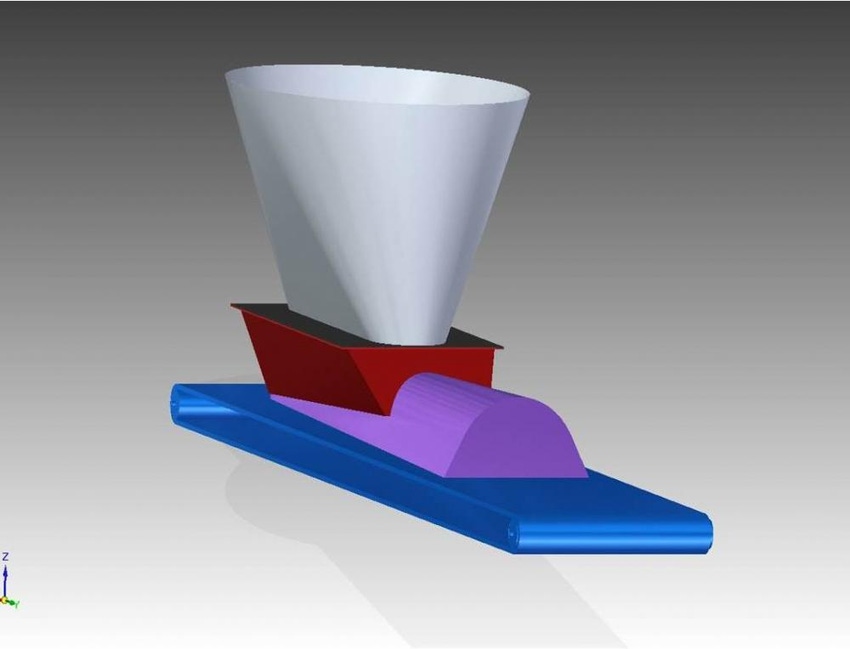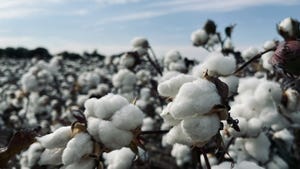How to Design a Belt Feeder Interface
January 22, 2015

In this article, we discuss proper belt feeder design technique so as to maintain reliable flow from bins and hoppers. Belt feeders are used to feed many types of bulk solids. In addition to their obvious benefits like simplicity and relatively low cost, they are one of the few feeder designs that can be used to feed product from a slot outlet. As well, cohesive and/or sticky materials and even materials with large particle sizes can be fed reliably. (see photo)
As we have discussed in previous articles, there are benefits to using a slot outlet or wedge type hopper, when mass flow is required. One of the most useful is the fact that for a given set of conditions (product, angle of friction) the slope to ensure mass flow at the sides of a wedge hopper can be significantly flatter than a conical mass flow hopper. A flatter mass flow hopper will always translate into lower headroom and a more economical design.
Interface or Transition Between the Wedge Outlet and Belt
A critical aspect of a mass flow hopper is that the feeder must withdraw product from the full cross section of the hopper outlet. This can be difficult to achieve with a long slot. A belt or screw feeder under a slot will typically withdraw product from a small area at the front or back of the slot unless the capacity of the feeder increases in the direction of discharge. The development of this preferential flow channel will ensure funnel flow with the potential for ratholing, segregation, flooding, etc.
To ensure that a belt feeder increases in capacity along its length, a properly designed interface is required. A well-designed interface between the slot outlet of the hopper and the belt will progressively discharge more product onto the belt along its length. This will make the full cross section of the hopper outlet live and therefore maintain mass flow (if the hopper slope is sufficiently steep for flow along the walls). An increasing capacity is achieved by controlling the position of the shear plane between the product in the hopper moving vertically down and the product in the feeder moving horizontally. (see photo of belt feeder interface)
Product Flow
As product flows down through the interface, since the major principle stresses are more-or-less horizontal, the vertical stresses acting through the shear plane are relatively low. This allows the belt to shear the product efficiently with a minimum amount of force. In addition, the vertical loads acting down onto the belt are relatively low and independent of the head of material in the hopper. Without a mass flow hopper and proper interface design, the loads on the belt would be high and a function of the head of material in the hopper. Therefore, the design of the hopper and the belt feeder and the loads on the belt are very much dependent and connected.
The interface design relies on a variable speed belt to achieve a variable product flow rate. There is no adjustable gate at the front of the hopper to adjust the cross section of product on the belt. Designs with adjustable gates cannot feed material uniformly – especially from a long slot. Therefore, they cannot be relied upon to support mass flow. In addition, since there is no natural separation between the product moving down in the hopper and the product moving horizontally on the belt, the shear is achieved by brute force shearing the product under a head of material. In funnel flow the head of material acting on the shear plane is high.
The figure shows an interface between a mass flow hopper and a flat belt that sometimes require skirts used to contain the product. (see belt feeder interface #2 photo) The nose at the front of the interface is projected out from the hopper area. This relieves the stresses on the product as it shears and also reduces the pressure on, and therefore wear of, the nose itself.
Conclusion
This interface design has been used successfully for many years for products with a very wide range of properties. Heavy, primary crushed ores to friable products and chemical powders have been successfully handled.
Joseph Marinelli is a consulting engineer and president of Solids Handling Technologies. He has been providing testing and consulting services since 1972. As a former consultant with Jenike & Johanson Inc., he has years of experience testing powders and designing bins and feeders for reliable flow. He lectures frequently on the topic of powder handling and has published several papers including and article in a chemical encyclopedia and two in a food powder book. For more information, conatct Joe at 803-802-5527 or [email protected]
For related articles, news, and equipment reviews, visit our Feeders Equipment Zone
You May Also Like


